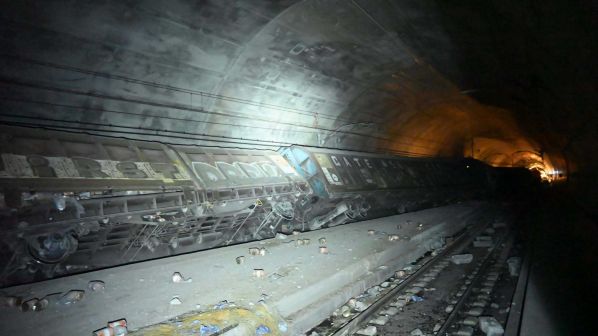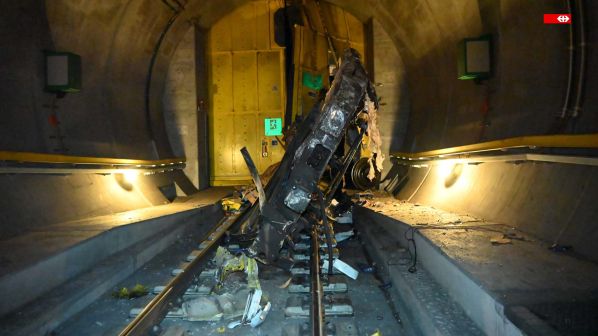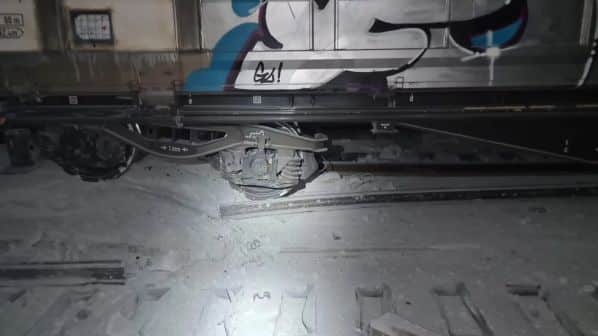THE Swiss Transportation Safety Investigation Board (Sust) has published its interim report into the derailment of a freight train in the Gotthard Base Tunnel on August 10, which caused significant damage and has resulted to continuing disruption to rail operation.
The report, published on September 28, says a freight train with 30 wagons hauled by SBB Cargo entered the southern entrance of the 57.09km tunnel, which opened at the end of 2016. Approximately 10km into the tunnel, a fragment of the wheel on the first axle of the 11th wagon broke away, with further fragments breaking off shortly after, leaving the axle hanging diagonally under the wagon and causing slight damage to the bi-block concrete sleepers.
The freight train continued for approximately 4km without causing any notable damage to the infrastructure.
Shortly before the Faido multifunctional site, 17km into the tunnel, the final wheel fragment broke off, with the hanging axle hitting the concrete sleepers and destroying the points at the multifunctional site. This caused the following 16 wagons to derail and partially overturn in the tunnel. The 13th and 14th wagons disconnected, with some wagons then diverted down the connecting track towards the opposite tunnel tube, damaging the safety doors between the tunnels.
Sust says the wheel was a type BA 390 wheelset with an axle load of 22.5 tonnes and a steel grade of ER7. The wheel was manufactured in 2008, and the axle had travelled approximately 140,000km since maintenance was last carried out.
After undertaking an initial metallurgical investigation of the broken wheel, Sust says the wheel failed due to fatigue (vibration cracks) starting from cracks in the tread. The crack developed in the wheel until it became a forced fracture. Several cracks oriented approximately perpendicular to the surface grew in parallel over a long period of time. The tread also had numerous other cracks.
Under the Joint Network Secretariat (JNS) system overseen by the European Union Agency for Railways (ERA), which issues safety alerts and procedures across Europe, an urgent safety alert was issued for freight wagons with BA 314 and BA 004 wheels in 2017 following various incidents in Italy and Belgium.
The Italian supervisory authority proposed an Urgent Procedure to the JNS, which decided to form the Urgent Procedure JNS Broken Wheels Task Force. On July 28 2017, short and long-term measures to limit risks during operation and maintenance of the wheelsets were defined and proposals for amendments to standards and regulations were submitted. On November 28 2019, a procedure on broken wheels was published by the taskforce.
Sust says the first results of the investigation and the metallurgical examination show a similarity with the wheel fractures that were the subject of the first procedure. However, Sust says a crack in a wheel disc cannot yet be detected by the state of the art of the train inspection equipment currently available in Switzerland on the infrastructure side. During technical train inspections in operation, a crack can only be detected to a limited extent, depending on its extent and only in the visible wheel area.
Sust says that at the time of publication of the interim report, there are no indications of preexisting operational deficiencies that could have caused the derailment.
Sust has recommended that the Swiss Federal Office of Transport (FOT) initiate an extension of the measures defined in the first urgent procedure for risk limitation during operation and maintenance of the wheelsets to type BA 390 wheelsets.
More detailed information on the metallurgical investigation will be included in the final report.
Passenger operation
SBB also announced on September 28 that it will resume the operate of some passenger services through the tunnel from September 29. Freight traffic through the undamaged eastern tunnel resumed on August 23, but passenger traffic has been diverted via the longer historic scenic route as the safety procedures for evacuating passengers in the event of an emergency required the use of both tunnels.
SBB says it will operate the passenger services on weekends when passenger demand is higher and freight demand is lower, and while repair work in the tunnel is paused.
SBB says it has now developed an adapted rescue concept, which has been examined by the FOT and an independent safety agency.
Only one passenger train will operate through the tunnel at a time, with one southbound Zürich to Lugano train running on Friday evening and one northbound train Locarno to Zürich on Sunday. This will then be increased to two additional southbound connections from Zürich to Bellinzona on Saturday morning and one northbound connection from Lugano to Zurich on Sunday.
From October 23 and until December 9, the Zürich - Genoa and Bologna - Zürich trains will once again run directly. However, passengers travelling in the opposite direction will continue to change trains in Chiasso. Until November 30, passengers will receive a 50% discount on luggage and bicycle transport to Ticino and back.
SBB will use double-deck coaches for the service to provide up to 900 seats. However, passengers are strongly advised to book a seat as the trains will not be able to run through the tunnel overloaded.
The trains will operate through the tunnel at reduced speed, reducing the journey time by between 15 and 30 minutes compared with the scenic route.
The full interim report (in German) is available here.



